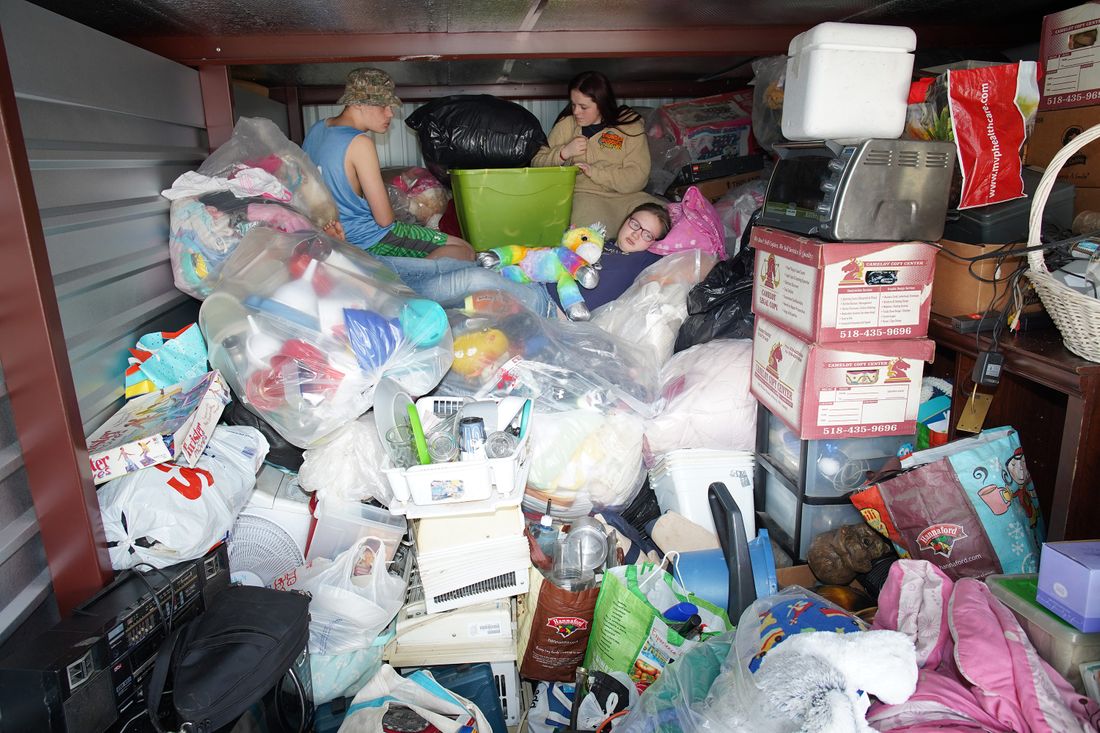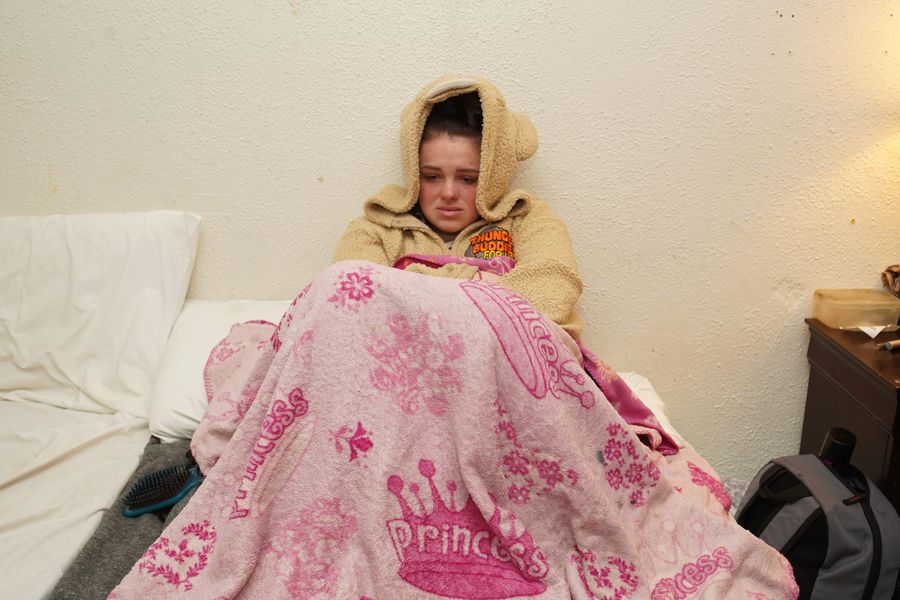April 8: Barbara’s storage unit, Troy, New York. The kids wanted to retrieve some personal items to take to the shelter. Amber cried while her brother and sister searched for the unicorn that Amber said would “calm her down.”
Photo: Brenda Ann Kenneally
When photographer Brenda Ann Kenneally drove from New York City to the upstate city of Troy, New York, in January, she said she felt like she was on her way to report on the apocalypse. Kenneally, 60, grew up in the region, and has spent decades capturing the lives and experiences of the families living below the poverty line there. In 2018, she released a book called Upstate Girls: Unraveling Collar City, which captured the day-to-day experiences of families in the region over the course of 14 years. It was a massive, collaborative effort, but almost as soon as it was done, Kenneally knew there was more work to be done. She had experienced poverty and homelessness growing up, and seen firsthand how all of the generational trauma, disinvestment, and marginalization had affected this community, where over a quarter of the population lives below the poverty line, and felt it had become incumbent upon her to stay with it. As she drove back in January, she said that everything felt so out of balance socially and economically, she couldn’t help but feel like she was documenting the end times. Then, the pandemic hit.
Kenneally decided to stay in Troy and work on her second book. As a photographer, she knew big, dramatic pictures would be coming from emergency rooms and from Black Lives Matter and other protests, but she knew her work was here: “I do believe you can tell every story in America through that one neighborhood.”
She bought a house in Troy, which is how she got to know Barbara, the subject of this photo essay. Barbara was her neighbor. She and her kids would go over to Kenneally’s to hang out, sit around bonfires, and scrapbook. Days before New York State’s eviction moratorium was enacted in March, Barbara, who lives on Social Security disability insurance, was evicted. Unable to tour new apartments due to COVID precautions, she and her three kids moved into the Schuyler Inn homeless shelter. Kenneally followed the family’s journey, supporting them when possible. She put Barbara in touch with Legal Aid when it looked like the shelter might evict them, and the family was able to stay.
Meanwhile, Andrew Cuomo was reporting on record numbers of COVID deaths, and schools were shutting down. Barbara and her family weren’t particularly afraid of COVID — it was just something that made their life that much harder. For example, though schooling for her three kids had moved online, the shelter didn’t have Wi-Fi, and the only internet available to the family was across the street at Burger King.
Now, finally, Barbara and her kids are in a new apartment. And for Kenneally, her work continues, and she hopes people will pay attention.
“I went through all that stuff, and eventually found photography, and I knew that there were things that were systematically unjust. I knew that since I was 12,” Kenneally says. “This is an outrage. This is something that needs to be seen. It’s an injustice.”
March 26: Barbara tunes in to the shelter’s ancient television to get her first real news about pandemic-related economic relief while her youngest daughter, Amber, tries to find amusement that doesn’t require internet on her mother’s cell phone. The Schuyler Inn family shelter was once a catwalk-style motel and has no internet or upgraded televisions.
Photo: Brenda Ann Kenneally
March 26: The shelter told the families who needed to access online lessons from their children’s schools that they should go across the street to Burger King and try to log on to the fast-food restaurant’s free Wi-Fi. Burger King’s indoor seating was closed due to coronavirus restrictions, so mother and daughter hunkered down in the parking lot to search for school information.
Photo: Brenda Ann Kenneally
March 26: There are no desks or tables in the rooms at the shelter, so Amber, 8, does a homework packet handed out when her school closed, and before a system for distribution of Chrome laptops to students had been put in place. Barbara occupies herself with a jigsaw puzzle on the floor.
Photo: Brenda Ann Kenneally
March 28: Amber eats a Cup O’ Noodles outside a converted shelter room called “The Kids’ Club.” The small and sparsely resourced play area offered the only programming for children at the facility, until the club closed due to the pandemic.
Photo: Brenda Ann Kenneally
April 4: The family in bed. Some of the hardest parts of living in the single-room occupancy at the shelter are social isolation and the lack of personal space. The two teenagers, Thomas and Ashley, can’t have any visitors, as per regular shelter rules, which are strictly enforced during the pandemic, and the family needs to navigate the age and gender-specific needs for privacy while accommodating the 8-year-old Amber’s need for comfort and connection.
Photo: Brenda Ann Kenneally
April 4: Barbara and Amber get ready for bed. Since Amber has been at the shelter, her go-to self-soothing method is thumb-sucking.
Photo: Brenda Ann Kenneally
April 8: Almost a month after Governor Cuomo issued the statewide order to close schools, Barbara and family realize that masks may be necessary. Widely varied information about COVID-19 that the kids got when extended family members took them for mini breaks from the shelter resulted in the kids thinking the virus was fake or, at best, the masks a dramatic overreaction. Nine days before a statewide mandatory mask order was issued, Barbara found one of the last three facial covering at Walmart. Paper masks were still a rare find, with access for essential health-care workers prioritized.
Photo: Brenda Ann Kenneally
April 11: Barbara checks the food in the cooler the family has stashed in their shelter room. Room and board is $1,400 a month, which the family must pay out of the disability that Barbara and her son Thomas receive. Preparing food in the rooms is forbidden, so there are no hot plates, microwaves, or refrigerators. The rooms are subject to random searches, so the cooler is often buried under plies of clothes. The kids say it’s worth the risk not to have to eat the “cheap but filling” shelter meals which they described as “nasty.”
Photo: Brenda Ann Kenneally
April 12: Ashley, sad about living in the shelter on Easter Sunday and with no hope of attending extended-family celebrations, wears her plush Thunder Cats jumper for comfort.
Photo: Brenda Ann Kenneally
April 13: Barbara gets the kids to do a thorough cleaning including under the shelter beds where the kids say it’s “scary” to look.
Photo: Brenda Ann Kenneally
April 13: Barbara collects empty bottles and cans from the grounds around the shelter. She cashes them in for two cents apiece for money to get little extras for the kids. After pushing a shopping cart full of them to a redemption center in the lobby of the local Price Chopper, she was met with a sign on the door announcing the redemption area was closed during COVID. She continues to collect and store the used bottles in the family room at the shelter, awaiting the day she can cash them all in.
Photo: Brenda Ann Kenneally
April 15: Barbara breaks down in tears after getting a call from the shelter desk saying she will be evicted in an hour if she does not pay the $1,400 in rent she owes. Barbara argues that the $1,400 would take the combined Social Security disability benefits of both her and her son, Thomas. Mother and son both have ADHD and PTSD and struggle with learning. The manger persisted, despite a statewide moratorium on evictions due to COVID-19. An hour before the manager was to physically remove their belongings, Barbara was able to get a legal-aid attorney to intervene via phone. The stay of eviction was tenuous, however, as there was a loophole regarding the length of tenancy and whether the stay of eviction applied to residents in a homeless shelter. Barbara’s daughter Amber comforted her mother, despite the fear that if they left the room they would be locked out.
Photo: Brenda Ann Kenneally














